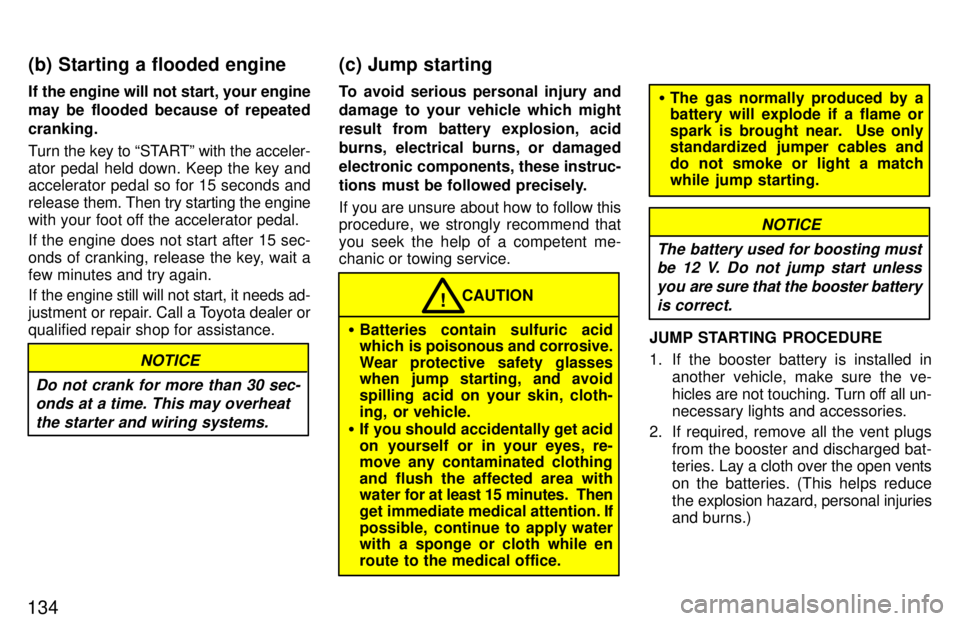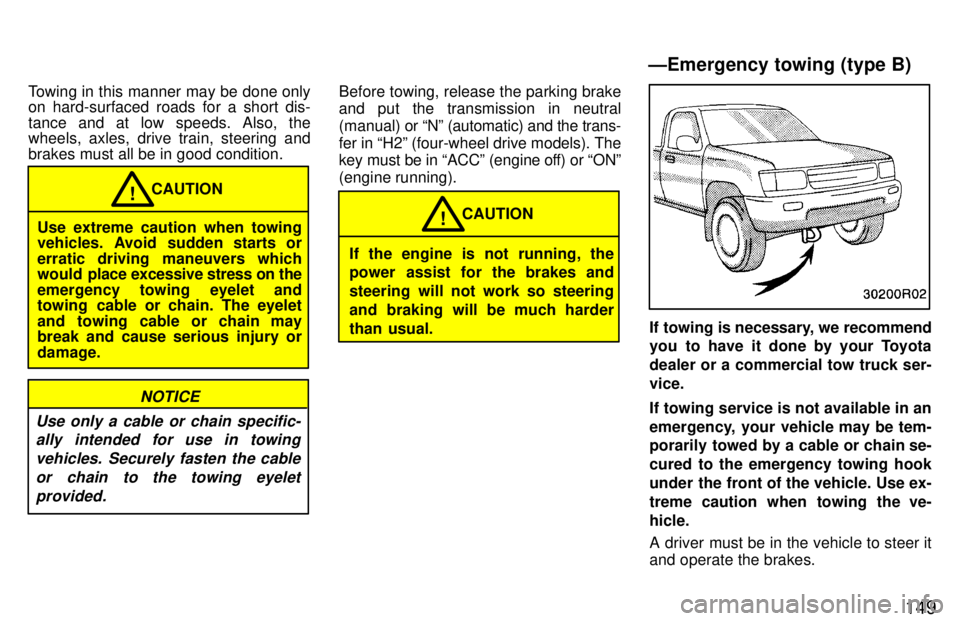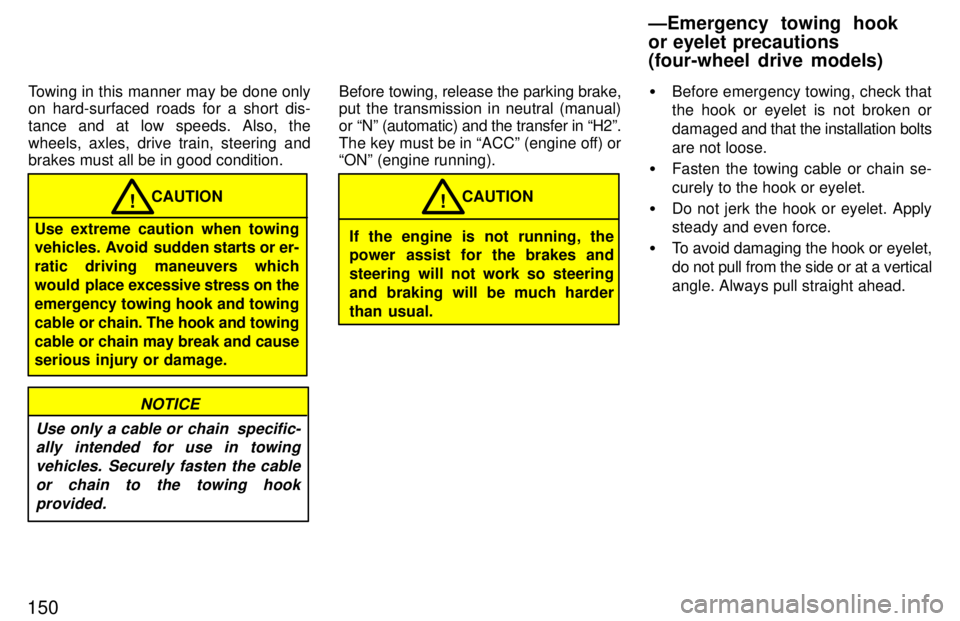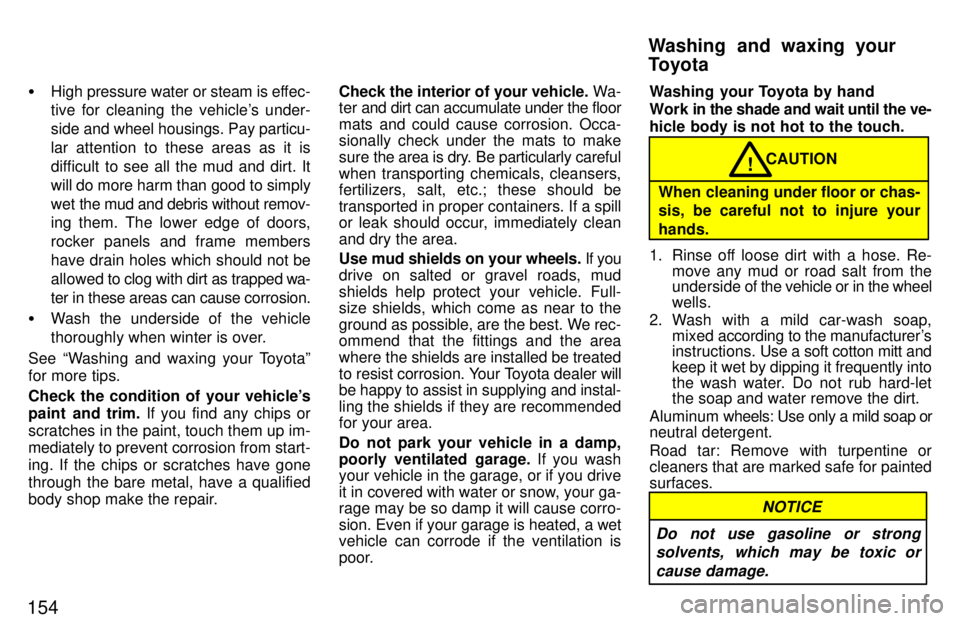1997 TOYOTA T100 park assist
[x] Cancel search: park assistPage 64 of 212

60(a) Brake System Warning Light This light has the following functions: Parking brake reminder
If this light is on, make sure the parking
brake is
fully released. The light should go
off.
Low brake fluid level warning
If this light comes on and stays on while
you are driving, slow down and pull off the
road. Then stop the vehicle carefully.There may be a problem somewhere in
the brake system. Check the fluid level of
the see-through reservoir.
To make sure the parking brake has not
caused the warning light to come on,
check to see that the parking brake is fully
released.
If the brake fluid level is low...
At a safe place, test your brakes by start-
ing and stopping. � If you judge that the brakes still work
adequately, drive cautiously to yournearest dealer or shop for repairs.
� If the brakes are not working, have the
vehicle towed in for repairs. (For tow-
ing information, see Part 4.)
It is dangerous to continue driving
normally when the brake fluid level
is low. CAUTION
!
If the brake fluid level is correct...
Have the warning system checked by
your Toyota dealer.
(b) Seat Belt Reminder Light and Buzzer
Once the ignition key is turned to ONº or
STARTº, the reminder light and buzzer
come on if the driver's seat belt is not fas- tened. Unless the driver fastens the belt,
the light stays on and the buzzer stops af-
ter about 4 to 8 seconds.
(c) Discharge Warning Light
This light warns that the battery is being discharged.
If it comes on while you are driving, there
is a problem somewhere in the charging system. The engine ignition will continue to oper-
ate, however, until the battery is dis-
charged. Turn off the air conditioning,
blower, ra
dio, ect., and drive directly to the
nearest Toyota dealer or repair shop.
NOTICE
Do not continue driving if the engine drive belt is broken or loose.
(d) Low Oil Pressure Warning Light
This light warns that the engine oil pres-
sure is too low.
If it flickers or stays on while you are
driving, pull off the road to a safe place
and stop the engine immediately. Call a
Toyota dealer or qualified repair shop forassistance.
The light may occasionally flicker when
the engine is idling or it may come on brief-
ly after a hard stop. There is no cause for concern if it then goes out when the en-
gine is accelerated slightly.
The light may come on when the oil level
is extremely low. It is not designed to indi- cate low oil level, and the oil level must be checked using the level dipstick.
Page 66 of 212

62(k) Unengaged Parkº Warning Light
(vehicles with automatic tranmis- sion)
This light warns that the transmission
Parkº mechanism is not engaged. If the
front drive control lever is in the Nº posi-
tion while the selector lever is in the Pº
position, the transmission will disengage
and the wheels will not lock.
To restore the park function, shift
the four-wheel drive control lever
out of Nº, or the vehicle can move. CAUTION
!
(l) Automatic Transmission Fluid Tem- perature Warning Light
This light warns that the automatic trans- mission fluid temperature is too high.
If this light comes on while you are driving,
slow down and pull off the road. Stop the
vehicle at a safe place and put the selector
lever in Pº. With the engine idling, wait
until the light goes off. If the light goes off,
you may start the vehicle again. If the light
does not go off, call a Toyota dealer or
qualified repair shop for assistance. (m)Low Windshield Washer Fluid
Level Warning Light (Canada)
The light warns that the windshield wash-
er fluid level is too low. Add washer fluid at
your earliest opportunity. (For instruc-
tions, see Adding washer fluidº in Chap-ter 7-3.)
CHECKING SERVICE REMINDER INDI-
CATORS (except the low fuel level
warning light)
1. Apply the parking brake.
2. Turn ignition key to ACCº. The SRS airbag warning light should
come on. It goes off after about 6 sec- onds.
3. Turn the ignition key to ONº, but do not start the engine.
All the service reminder indicators ex-
cept the SRS airbag warning light
should come on. The ABSº warning
light goes off after about 3 seconds.
If any service reminder indicator or warn-
ing buzzer does not function as describedabove, either the bulb is burned out or the
circuit is in need of repair. Have it checked
by your Toyota dealer as soon as pos- sible.
Page 117 of 212

11 3
The diluting ingredients evaporate out
when the vehicle is then driven at high
speeds, as on an expressway, making itappear that oil is excessively consumed
after driving as high speeds.
IMPORTANCE OF ENGINE OIL LEVEL CHECK
One of the most important points in proper vehicle maintenance is to keep the engine
oil at the optimum level so that oil function
will
not be impaired. Therefore, it is essen-
tial that the oil level be checked regularly.
Toyota recommends that the oil level bechecked every time you refuel the vehicle.
Failure to check the oil level
regularly could lead to serious
engine trouble due to insufficient oil.
NOTICE
For detailed information on the oil level
check, see Checking the engine oil levelº
in Chapter 7-2.
Your engine is fitted with twin ground elec- trode spark plugs.
Use only twin ground electrode
spark plugs for your engine
performance.
NOTICE
TANDEM MASTER CYLINDER BRAKE SYSTEM
The tandem master cylinder brake sys-
tem is a hydraulic system with two sepa-
rate sub-systems. If either sub-system
should fail, the other w ill still work. Howev-
er, the pedal will be harder to press, and
your stopping distance will be longer.
Also, the brake system warning light may come on.
CAUTION!
Do not drive your vehicle with only a single brake system. Have your
brakes fixed immediately.
BRAKE BOOSTER
The brake booster uses engine vacuum to
power-assist the brakes. If the engine
should quit while you are driving, you can
bring the vehicle to a stop with normal
pedal pressure. There is enough reserve
vacuum for one or two stops - but no more!
Twin ground electrode spark
plugs (5VZ-FE engine) Brake system
Page 126 of 212

122Before starting the engine, be sure to fol-
low the instructions in (a) Before crank- ingº.
Normal starting procedure
The multiport fuel injection system/se-
quential multiport fuel injection system in
your engine automatically controls the
proper air-fuel mixture for starting. You can start a cold or hot engine as follows:
1. With your foot off the accelerator ped-
al, crank the engine by turning the key
to STARTº. Release it when the en-
gine starts.
2. After the engine runs for about 10 sec-
onds, you are ready to drive.
If the weather is below freezing, let the en-
gine warm up for a few minutes before driving.
If the engine stalls...
Simply restart it, using the correct proce- dure given in normal starting. If the engine will not startÐ
See If your vehicle will not startº in Part 4. �
Do not crank for more than 30
sec-
onds at a time. This may overheat
the starter and wiring systems.
�Do not race a cold engine.
�If the engine becomes difficult to
start or stalls frequently, have theengine checked immediately.
NOTICE� Always slow down in gusty cross- winds. This will allow you much bettercontrol.
� Drive slowly onto curbs and, if pos-
sible, at a right angle. Avoid drivingonto high, sharp-edged objects and
other road hazards. Failure to do so
can lead to severe tire damage result-
ing in tire bursts.
� When parking on a hill, turn the front
wheels until they touch the curb so that
the vehicle will not roll. Apply the park-
ing brake, and place the transmission in Pº (automatic) or in first or reverse
(manual). If necessary, block thewheels.
� Washing your vehicle or driving
through deep water may get the
brakes wet. To see whether they are
wet, check that there is no traffic near
you, and then press the pedal lightly. If
you do not feel a normal braking force,
the brakes are probably wet. To dry
them, drive the vehicle cautiously
while lightly pressing the brake pedal
with the parking brake pulled. If they
still do not work safely, pull to the side
of the road and call a T oyota dealer for
assistance.
(b) Starting the engine
Tips for driving in various conditions
Page 138 of 212

134If the engine will not start, your engine
may be flooded because of repeated cranking.
Turn the key to STARTº with the acceler-
ator pedal held down. Keep the key and accelerator pedal so for 15 seconds and
release
them. Then try starting the engine
with your foot off the accelerator pedal.
If the engine does not start after 15 sec-
onds of cranking, release the key, wait afew minutes and try again.
If the engine still will not start, it needs ad-
justment or repair. Call a Toyota dealer or
qualified repair shop for assistance.
NOTICE
Do not crank for more than 30 sec- onds at a time. This may overheat
the starter and wiring systems.
To avoid serious personal injury and
damage to your vehicle which might
result from battery explosion, acid
burns, electrical burns, or damaged
electronic components, these instruc-
tions must be followed precisely.
If you are unsure about how to follow this procedure, we strongly recommend that you seek the help of a competent me-
chanic or towing service.
� Batteries contain sulfuric acid
which is poisonous and corrosive.
Wear protective safety glasses
when jump starting, and avoid
spilling acid on your skin, cloth-
ing, or vehicle.
� If you should accidentally get acid
on yourself or in your eyes, re- move any contaminated clothing
and flush the affected area with water for at least 15 minutes. Then
get immediate medical attention. If
possible, continue to apply water
with a sponge or cloth while en
route to the medical office. CAUTION
!
�
The gas normally produced by a battery will explode if a flame or
spark is brought near. Use only
standardized jumper cables and
do not smoke or light a match
while jump starting.
NOTICE
The battery used for boosting must be 12 V. Do not jump start unless
you are sure that the booster batteryis correct.
JUMP STARTING PROCEDURE
1. If the booster battery is installed in another vehicle, make sure the ve-
hicles are not touching. T urn off all un-
necessary lights and accessories.
2. If required, remove all the vent plugs from the booster and discharged bat-
teries. Lay a cloth over the open vents
on the batteries. (This helps reduce
the explosion hazard, personal injuries
and burns.)
(b) Starting a flooded engine (c) Jump starting
Page 153 of 212

149
Towing in this manner may be done only
on hard-surfaced roads for a short dis-
tance and at low speeds. Also, the
wheels, axles, drive train, steering and brakes must all be in good condition.
CAUTION!
Use extreme caution when towing
vehicles. Avoid sudden starts or
erratic driving maneuvers which
would place excessive stress on the
emergency towing eyelet and
towing cable or chain. The eyelet
and towing cable or chain may break and cause serious injury or damage.
NOTICE
Use only a cable or chain specific- ally intended for use in towing
vehicles. Securely fasten the cableor chain to the towing eyelet provided.
Before towing, release the parking brake
and put the transmission in neutral
(manual) or Nº (automatic) and the trans-
fer in H2º (four-wheel drive models). The
key must be in ACCº (engine off) or ONº
(engine running).
CAUTION!
If the engine is not running, the
power assist for the brakes and
steering will not work so steering
and braking will be much harder
than usual.
If towing is necessary, we recommend
you to have it done by your Toyota
dealer or a commercial tow truck ser-vice.
If towing service is not available in an
emergency, your vehicle may be tem-
porarily towed by a cable or chain se-
cured to the emergency towing hook
under the front of the vehicle. Use ex-
treme caution when towing the ve-hicle.
A driver must be in the vehicle to steer it and operate the brakes.
ÐEmergency towing (type B)
Page 154 of 212

150Towing in this manner may be done only
on hard-surfaced roads for a short dis-
tance and at low speeds. Also, the
wheels, axles, drive train, steering and brakes must all be in good condition.
CAUTION!
Use extreme caution when towing
vehicles. Avoid sudden starts or er- ratic driving maneuvers which
would place excessive stress on the
emergency towing hook and towing
cable or chain. The hook and towing
cable or chain may break and cause
serious injury or damage.
NOTICE
Use only a cable or chain specific- ally intended for use in towing
vehicles. Securely fasten the cableor chain to the towing hook provided.
Before towing, release the parking brake, put the transmission in neutral (manual)
or Nº (automatic) and the transfer in H2º.
The key must be in ACCº (engine off) or ONº (engine running).
CAUTION!
If the engine is not running, the
power assist for the brakes and
steering will not work so steering
and braking will be much harder
than usual. �
Before emergency towing, check that the hook or eyelet is not broken or
damaged and that the installation bolts
are not loose.
� Fasten the towing cable or chain se-curely to the hook or eyelet.
� Do not jerk the hook or eyelet. Apply
steady and even force.
� To avoid damaging the hook or eyelet, do not pull from the side or at a vertical
angle. Always pull straight ahead.
ÐEmergency towing hookor eyelet precautions (four-wheel drive models)
Page 158 of 212

154�
High pressure water or steam is effec-
tive for cleaning the vehicle's under-
side and wheel housings. Pay particu-
lar attention to these areas as it is
difficult to see all the mud and dirt. It
will do more harm than good to simply
wet the mud and debris without remov-
ing them. The lower edge of doors,
rocker panels and frame members
have drain holes which should not be
allowed to clog with dirt as trapped wa-
ter in these areas can cause corrosion.
� Wash the underside of the vehicle
thoroughly when winter is over.
See Washing and waxing your Toyotaº
for more tips.
Check the condition of your vehicle's
paint and trim. If you find any chips or
scratches in the paint, touch them up im- mediately to prevent corrosion from start- ing. If the chips or scratches have gone
through the bare metal, have a qualified
body shop make the repair. Check the interior of your vehicle.
Wa-
ter and dirt can accumulate under the floor
mats and could cause corrosion. Occa-
sionally check under the mats to make sure the area is dry. Be particularly careful
when transporting chemicals, cleansers,
fertilizers, salt, etc.; these should be
transported in proper containers. If a spill
or leak should occur, immediately clean
and dry the area.
Use mud shields on your wheels. If you
drive on salted or gravel roads, mud
shields help protect your vehicle. Full- size shields, which come as near to the
ground as possible, are the best. We rec-
ommend that the fittings and the area
where the shields are installed be treated
to resist corrosion. Your Toyota dealer will
be happy to assist in supplying and instal-
ling the shields if they are recommended for your area.
Do not park your vehicle in a damp, poorly ventilated garage. If you wash
your vehicle in the garage, or if you drive
it in covered with water or snow, your ga- rage may be so damp it will cause corro-
sion. Even if your garage is heated, a wet
vehicle can corrode if the ventilation is
poor. Washing your Toyota by hand
Work in the shade and wait until the ve-
hicle body is not hot to the touch.
CAUTION
When cleaning under floor or chas-
sis, be careful not to injure your hands.!
1. Rinse off loose dirt with a hose. Re- move any mud or road salt from the
underside of the vehicle or in the wheel
wells.
2. Wash with a mild car-wash soap, mixed according to the manufacturer's
instructions. Use a soft cotton mitt and
keep it wet by dipping it frequently into
the wash water. Do not rub hard-let the soap and water remove the dirt.
Aluminum wheels: Use only a mild soap or
neutral detergent.
Road tar: Remove with turpentine or
cleaners that are marked safe for paintedsurfaces.
Do not use gasoline or strong
solvents, which may be toxic or
cause damage.
NOTICE
Washing and waxing your
Toyota